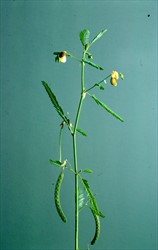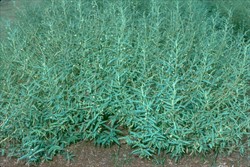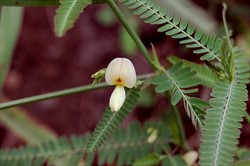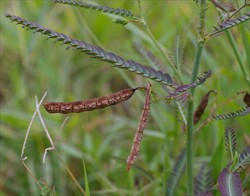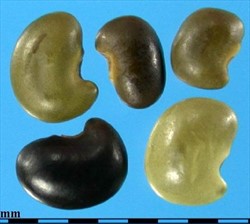Tropical Forages
Aeschynomene indica L.
Note: The genus, Aeschynomene, is separated into two sections: Aeschynomene and Ochopodium. The former encompasses predominantly species from humid environments, such as Aeschynomene americana, Aeschynomene indica and Aeschynomene villosa, while the latter includes a number of dryland species, such as Aeschynomene brasiliana, Aeschynomene falcata and Aeschynomene histrix.
Family: Fabaceae (alt. Leguminosae) subfamily: Faboideae tribe: Dalbergieae.
An erect, annual (sometimes perennial) herb or sub-shrub, 0.3‒2.5 m tall. Stems hollow, pithy, mostly to about 5 mm diameter (to 2.5 cm diameter at the base); glabrous to moderately hispid with sometimes glandular hairs. Leaves pinnate, occasionally sensitive, 5‒10 cm long, mostly to 50- (sometimes to 70-) foliolate; leaflets linear-oblong, 3‒13 mm long, 1‒3 mm wide, glabrous. Inflorescences comprising 1‒6 flowers; standard yellow or whitish, mostly lined and suffused with red outside, or purplish, elliptic, 7‒10 mm long, 4‒7 mm wide; wings and keel greenish white or pale yellow. Pod linear, straight or slightly curved, 2.4‒4.8 cm long (excluding the stipe), 5‒13 jointed, one suture more or less straight, the other slightly scalloped between the articles. Articles oblong, 3‒5 mm long and wide, compressed with sparse, short, tubercular-based hairs, central part raised. Seed dark olive-black or brownish, oblong, slightly beaked, 3‒4 mm long, 2‒3 mm thick. 80,000‒300,000 (av. 140,000) seeds/kg (22 accessions).
Similar species
Aeschynomene indica: pod segments almost square.
Aeschynomene americana: lower suture of the pod pronouncedly scalloped between the joints i.e. lower border of the segments curved.
Asia: 合萌 he meng (China); dinding, gedeyan, katisan, lorotis, peupeuteuyan, tis (Indonesia); kusanemu (Japan); makahiyang lalaki (Philippines); sano haag kai (Thailand)
English: budda pea, curly indigo, Indian jointvetch, hard sola, kat sola, northern jointvetch, sensitive jointvetch, sensitive Malayan vetch, sensitive vetch, southern joint vetch
Europe: eschynomene (French); indische Schampflanze, virginische Schampflanze (German); pianta modesta bastarda (Italian)
India: didhen, phulan, chhuimui, laugauni (Hindi); nalabi (Marathi); chatai, kitai, kitaichchi, netti, takkaippuntu (Tamil); neli-tali, nelitali, nellittali (Malayalam); jeeluga, tella jeeluga, bendu (Telugu); bedukasa, bendukasa, bendu kasa (Kannada); kath shola (Bengali); surlo (Oriya); কুহীলা kuhila (Assamese)
Latin America: angiquinho, maricazinho, papquinha, pinheirinho (Brazil); anil rizado (Spanish)
Pacific: ikin sihk (Pohnpei)
Native/naturalized:
Northern America: Mexico (Tabasco, Tamaulipas); USA (Alabama, Arkansas, Florida, Georgia, Louisiana, Mississippi, North Carolina, South Carolina, Texas)
Caribbean: Puerto Rico
South America: Brazil
Africa: Angola, Botswana, Burundi, Cameroon, Chad, Democratic Republic of Congo (Zaire), Ethiopia, Gabon, Ghana, Guinea Bissau, Kenya, Malawi, Mali, Mauritania, Mozambique, Namibia, Niger, Nigeria, Rwanda, Sao Tome & Principe, Senegal, Somalia, South Africa, Sudan, Tanzania, The Gambia, Togo, Uganda, Zambia, Zimbabwe
Asia: Afghanistan, Bangladesh, Bhutan, Brunei, Cambodia, China, India, Indonesia, Iran, Japan, Korea, Laos, Malaysia, Myanmar, Pakistan, Philippines, Ryukyu Is., Sri Lanka, Taiwan, Thailand, Vietnam
Australasia/Pacific: Australia, Fiji, Papua New Guinea, Northern Marianas, Society Is., West Papua Niugini (Irian Jaya)
Indian Ocean: Madagascar, Mauritius, Réunion, Rodrigues
Note: The exact native range is obscure.
Forage
Generally not considered a forage due to low palatability and possible toxicity. May have application as a fodder crop in rotation with rice.
Environment
A freely nodulating nitrogen-fixing species, Aeschynomene indica can be used as green manure.
Other
The leaves can be prepared in various ways for human consumption, and have a role in folk medicine to treat a wide range of conditions. Pith from the stem can be used for floatation, and the woody stems can be used as fuel, either dry or as charcoal.
Soil requirements
Largely on soils with texture ranging from sandy loam to clay, with pH from 4.5 to 8; sometimes on black saline soils. Distribution more determined by moisture availability and drainage than by soil texture.
Moisture
Found in seasonally flooded waterlogged grassland, freshwater swamp and aquatic vegetation.
Temperature
Extremely widely distributed throughout the tropics and subtropics, from near sea level to 1,530 m asl, and from about 35º N in North Carolina (USA) and 28º S in NSW (Australia), to near the equator in Africa, Papua New Guinea and South America. This equates to a range in average annual temperatures from about 17 to 27 ºC.
Light
No information available.
Reproductive development
Most lines tested commenced flowering between late January and late February at 21º S, the latest commencing in late March.
Defoliation
No information available.
Fire
No information available, but probably susceptible.
Guidelines for establishment and management of sown forages.
Establishment
Mechanical scarification of hand-harvested seed may be necessary to overcome hardseededness. Aeschynomene indica appears to be somewhat promiscuous, but may nodulate more effectively with Aeschynomene inoculum CB 2312. Can form nodules at the base of the stem.
Fertilizer
No information available.
Compatibility (with other species)
No information available.
Companion species
Grasses: Grows in similar environments to Hemarthria altissima and Acroceras macrum.
Legumes: Often growing together with Sesbania spp. and Acacia nilotica subsp. tomentosa. Could grow with other water-loving, but not overly aggressive species such as Aeschynomene americana and Vigna luteola.
Pests and diseases
Susceptible to anthracnose caused by Colletotrichum gloeosporioides f.sp. aeschynomene.
Ability to spread
Spreads by seed in areas where conditions are suitable.
Weed potential
Can be a serious weed in rice paddies. Rarely found in any quantity beyond wet areas such as drainage ditches.
Nutritive value
No information available.
Palatability/acceptability
Low to moderate palatability.
Toxicity
There is evidence of toxicity of green plant material to ruminants. Seeds as contaminants in feed grain can be toxic to pigs, causing a vestibulo-cerebellar disorder.
Dry matter
No information available.
Animal production
No information available.
2n = 40.
No information available.
Susceptible to the microbiological herbicide, C. gloeosporioides f.sp. aeschynomene ATCC 20358, which also attacks other Aeschynomene species in the series Indicae: Aeschynomene virginica, Aeschynomene evenia, Aeschynomene rudis and Aeschynomene scabra.
- Adapted to wet, seasonally flooded land.
- Fixes nitrogen.
- Not very palatable.
- At least some lines may be toxic.
- Frequently stemmy (low leaf:stem ratio).
- Weed potential in paddy rice.
Bielig, L.M. (1997) Chromosome numbers in the forage legume genus, Aeschynomene L. Sabrao Journal of Breeding and Genetics 29:33–39.
Bishop, H.G., Pengelly, B.C. and Ludke, D.H. (1988) Classification and description of a collection of the legume genus, Aeschynomene. Tropical Grasslands 22:160–175. bit.ly/2w4MyoG
Kretschmer Jr., A.E. and Bullock, R.C. (1980) Aeschynomene spp.: Distribution and potential use. Proceedings of the Soil and Crop Science Society of Florida 39:145–152. ufdc.ufl.edu/AA00067243/00024/153j
Rudd, V.E. (1955) The American species of Aeschynomene. Contributions from the United States National Herbarium 32:1–172. hdl.handle.net/10088/27083
None released.
None reported.
